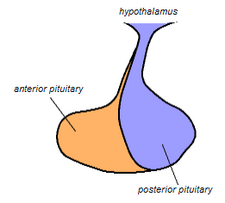m (Changed protection level for "Acromegaly" ([edit=sysop] (indefinite) [move=sysop] (indefinite))) |
m (Unprotected "Acromegaly": Bot: Unprotecting page) |
(No difference)
| |
Latest revision as of 23:26, 23 May 2012

The pituitary gland, anterior and posterior sections. Somatotropin is produced by the anterior portion of the pituitary gland (shown here in soft orange).
Acromegaly (also known as hypersomatotropism) is a hormonal condition resulting from over-secretion of growth hormone, known as somatotropin [1] from the pituitary gland.[2] This hormone is responsible for growth from birth to adulthood. At adulthood, secretions of the growth hormone slow dramatically and growth normally stops. In acromegaly, the bones continue to grow. Because the bone plates will still close upon entering adulthood, continuing growth is not in normal proportions.
The effect of excess growth hormone is similar to the effect of steroids in the respect that it causes insulin resistance [3] and hyperglycemia (high blood glucose). [4] Animals with acromegaly often are diabetic. Since acromegaly [5] is an endocrine disease, its sufferers can also be prone to neuropathy. They are also prone to various eye problems as a result of this endocrine disease.[6]
In dogs[]
In dogs, the condition often develops due to excess progesterone [7] secretion (as happens with ovarian cysts). The usual canine sufferers of acromegaly are unspayed females. Spaying usually may cure the condition [8]. Using medication containing progesterones can also result in an excess of growth hormone.[9][10][11][12]
The symptoms can include overgrowth or enlargement of gums with wide spaces between teeth,[8] increased drinking, increased urination, thickening of the skin and skin folds, enlargement of the tongue and excessive panting. Acromegaly is also possible from a somatotroph adenoma.[13] The hormone somatostatin can also be useful in treatment.[14] Since hypothyroidism is connected with the release of excess growth hormone, hypothyroidism can be mistaken for acromegaly.[15]
There is a transient form of acromegaly which can affect females at the diestrus [16] portion of the reproductive cycle. This condition is brought about by the mammary glands [17] excreting excess growth hormone, which is triggered by progesterone from the ovaries. As with non-transient acromegaly, spaying is necessary. [18] ![]()
References[]
- ↑ Growth Hormone. School of Veterinary Medicine-Colorado State.
- ↑ Herrtage, Michael. Pituitary Disorders. University of Cambridge.
- ↑ Rijnberk, A, Kooistra, HS, Mol, JA. (2003). Similarities in Canine/Feline Endocrine Disorders to Human Endocrine Disorders. Growth Hormone & IGF Research.
- ↑ Urine Glucose. Cornell University.
- ↑ Endocrine Disease and Neuropathy. Southpaws.
- ↑ Plummer, Caryn E., Specht, Andrew, Gelatt, Kirk N. (December 2007). Ocular Manifestations of Endocrine Disease. Compendium.
- ↑ Brooks, Wendy C.. Explanation of Progesterone's Functions. Veterinary Partner.
- ↑ 8.0 8.1 Acromegaly. NAVC Clinicians Brief (June 2006).
- ↑ Progestrone Use and Growth Hormone Excess. Intervet.
- ↑ Eigenmann, JE, Eigenmann, RY, Rijnberk, A, van der Gaag, I, Zapf, J, Froesch, ER. (1983). Progesterone-controlled Growth Hormone Overproduction and Naturally Occurring Canine Diabetes and Acromegaly. Acta Endocrinologica.
- ↑ Rijnberk, A, Eigenmann, JE, Belshaw, BE, Hampshire, J, Altszuler, N. (1980). Acromegaly associated with transient overproduction of growth hormone in a dog. Journal-American Veterinary Medical Association.
- ↑ Mosallanejad, B., et. al. (2005). Progesterone-Induced Canine Acromegaly. WSAVA.
- ↑ F. Fracassi, et al. (2005). Acromegaly Due to a Somatroph Adenoma in a Dog. Veterinary Clinics of North America.
- ↑ Introduction to Somatostatin. Colorado State School of Veterinary Medicine.
- ↑ Lee, W M, et al. (2001). Primary Hypothyroidism in Dogs is Connected with Growth Hormone (GH) Release. Utrecht University.
- ↑ Canine reproduction-female cycle. Wikipedia.
- ↑ Rijnberk A. (2002). The mammary gland, an endocrine gland. Nederlands Tijdschrift voor Geneeskunde (PubMed Summary in English).
- ↑ Cook, Audrey (1 April 2010). Identifying the reasons behind difficult-to-control diabetes in dogs. DVM 360.
More Information[]
- Transient Diabetes Insipidus in a Dog With Acromegaly Schwedes CS., Journal of Small Animal Practice, 1999
- Pancreatic Islet Ultrastructure, Serum & Pancreatic Immunoreactive Insulin in Somatotrophic and Metasomatotrophic Diabetes in Dogs Campbell J, Pierluissi J, Kovacs K., Journal of Submicroscopic Cytology, 1981
- Acromegaly North American Veterinary Conference-2006
- Treatment of Excess Growth Hormone in Dogs with Progesterone Receptor Antagonist Aglepristone S.F.M. Bhatti, et. al., Theriogenology, 2006
- Metasomatotrophic Diabetes & Its Induction J. Pierluissi, J. Campbell, Diabetelogica, 1980
- The Hard To Regulate Diabetic Dog Brooks, Wendy C., Veterinary Partner-article discussing acromegaly, among other topics
- Hormones Which Raise or Lower Blood Glucose Clinical Chemistry
- Acromegaly in the Dog Eigenmann JE., Veterinary Clinics of North America, 1984
- Vetsulin-Diabetes-Related Diseases Intervet
- The Diagnostic Approach to Polyuria in the Dog Kooistra, Hans S., WSAVA, 2010
- Ocular Manifestations of Systemic Disease in Small Animals Dennis E. Brooks, University of Florida School of Veterinary Medicine